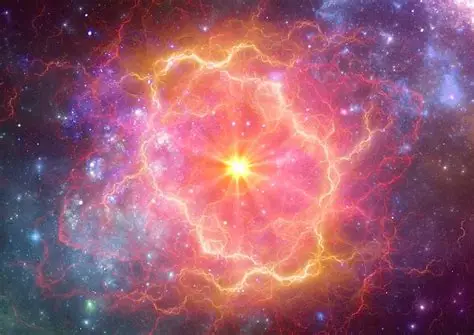August 16,2025 | SKY LINK TIMES’s SPACE DESK
In a groundbreaking discovery, astronomers have observed a new type of supernova triggered by the destructive gravitational dance between a massive star and a black hole. The rare cosmic event, detected about 700 million light-years from Earth, reveals how black holes can dramatically alter the life and death of stars.

According to a study published in the Astrophysical Journal, the doomed star — at least 10 times more massive than the Sun — was locked in a binary system with a black hole of similar mass. Over time, the black hole’s immense gravity distorted the star, siphoning off its material and ultimately causing it to explode in a spectacular supernova.
“We caught a massive star locked in a fatal tango with a black hole,” said Alexander Gagliano, astrophysicist at MIT and lead author of the study.
“After shedding mass for years in a death spiral with the black hole, the massive star met its finale by exploding. It released more energy in a second than the Sun has across its entire lifetime.”
How It Happened
- The star and black hole were gravitationally bound in a binary system.
- The black hole gradually stripped the star of its outer layers, exposing its helium core.
- Bright emissions were detected years before the final explosion, caused by the black hole devouring stellar material.
- Finally, the star exploded in a New type of supernova, with leftover debris rapidly consumed by the black hole.
Scientists say it remains unclear whether the explosion was triggered by the star’s collapse due to gravitational instability or if the black hole tore the star apart before it went supernova.
🚀 AI Detected It First
Interestingly, the event was first flagged by an artificial intelligence algorithm designed to scan the skies for unusual stellar explosions. The system provided real-time alerts, allowing astronomers to capture the rare event using multiple telescopes worldwide.
Why It Matters
This discovery sheds new light on the complex relationship between stars and black holes:
- It shows that black hole companions can directly trigger supernovae, altering how stars end their lives.
- The black hole involved grew more massive and powerful after devouring the leftover stellar material.
- The finding opens new research into how binary systems influence stellar evolution and the role of black holes in shaping galaxies.
ALSO READ: Apple Refines Liquid Glass Design in iOS 26 Beta 6 | September Launch
“Our takeaway is that the fates of stars are incredibly impacted by their companion. This event gives us an exciting window into how dramatically black holes can influence the deaths of massive stars,” said co-author Ashley Villar of Harvard University.
What’s Next?
Astronomers believe stars at least eight times larger than the Sun typically end in supernovae, while those 20 times larger collapse into black holes. But this new event demonstrates that a stellar companion — especially a black hole — can fundamentally change this process.
The discovery not only adds a new category to known supernovae but also highlights how AI-driven astronomy is revolutionizing our understanding of the universe.
For More Info Stay Tuned: https://skylinktimes.in



